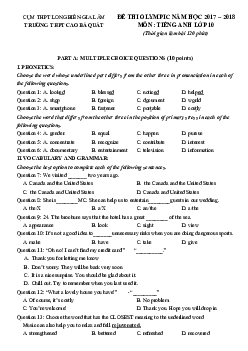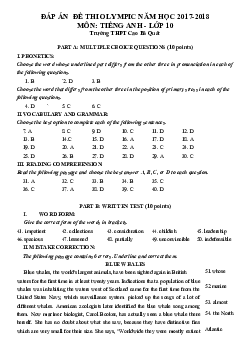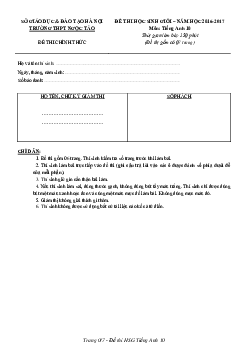






Preview text:
SỞ GD&ĐT HẢI DƯƠNG
KỲ THI NĂNG KHIẾU LẦN 5 TRƯỜNG THPT CHUYÊN NĂM HỌC 2020 - 2021 NGUYỄN TRÃI
MÔN: TIẾNG ANH KHỐI 10 CHUYÊN ĐỀ
Thời gian làm bài: 180 phút (không kể thời gian giao đề) ĐỀ CHÍNH THỨC
(Đề thi có 7 trang)
Ngày thi: 19 tháng 04 năm 2021 PART 1: LISTENING (40 points)
I. Listen to a conversation on a university campus and choose the correct option. (10 points)
1. What is the woman’s status at the university? A. She is a senior. B. She is a junior.
C. She’s a transfer student.
D. She’s a graduate student.
2. What is the man’s status at the university? A. He is a senior. B. He is a tutor. C. He’s a transfer student. D. He’s a graduate student.
3. What does the man want to learn from the woman?
A. How to transfer to a junior college.
B. How to find his way around campus.
C. The course requirements for a literature major.
D. Who won the campus election.
4. How many total courses must a student take for a literature major? A. Three B. Five C. Eight D. Ten
5. The man will probably take his elective courses in which area? A. American literature B. World literature C. Literary analysis D. Surveying
II. You will hear an explorer called Richard Livingstone talking about a trip he made in the
rainforest of South America. Listen and indicate true (T) or false (F) statements. (10 points) Statements T F
1. They went all the way by boat.
2. Richard say that during the walk, they were always both cold and wet.
3. In a deserted camp, they found some soup made from unusual meat and vegetables.
4. After the meal, they began to feel worried about what they have done.
5. Before leaving the camp, they left the sum of 50 dollars to thank the host.
III. You will hear part of a radio programme about toys, in which the development of a famous toy
called Meccano is described. Complete the sentences with a word or short phrase. (20 points)
Frank Hornby worked for a ___________________________ (1).
He was inspired by a book called ___________________________ (2).
The __________________________ (3) he invented did not work properly.
He started to consider the idea of ___________________________ (4) parts.
He decided that the parts would need to have a _______________________ (5) in them.
The first parts he made were from a big ___________________________ (6).
The first object that was built with the new system was a _____________________ (7).
The first name given to the new toy was ___________________________ (8).
Each Meccano set could be made bigger with the use of an ____________________ (9).
Hornby _____________________(10) arrived in 1925, followed by speedboats, and other toys in 1933. 1 SỞ GD&ĐT HẢI DƯƠNG
KỲ THI NĂNG KHIẾU LẦN 5 TRƯỜNG THPT CHUYÊN NĂM HỌC 2020 - 2021 NGUYỄN TRÃI
MÔN: TIẾNG ANH KHỐI 10 CHUYÊN ĐỀ
Thời gian làm bài: 180 phút (không kể thời gian giao đề) ĐỀ CHÍNH THỨC
(Đề thi có 7 trang)
Ngày thi: 19 tháng 04 năm 2021
PART 2: LEXICO - GRAMMAR (40 points)
I. Choose the word or phrase that best fits the gap in each sentence (20 points)
1. You are under no obligation to help as assistance is purely ______________. A. voluntary B. free C. charitable D. donated
2. I’m afraid you may find the truth somewhat ___________. A. inedible B. unpalatable C. indigestible D. unmanageable
3. She’s very _____________. She can be relied on to do her job properly. A. efficient B. cautious C. serious D. conservative
4. The youth team really _____________ themselves in the semi-final. A. surmounted B. exceeded C. beat D. excelled
5. The speeding car only missed us by a hair’s ___________. A. breadth B. height C. width D. length
6. Humanity has done great damage to the environment in its search for _________ materials. A. live B. raw C. crude D. rude
7. _________, the balcony chairs will be ruined in this weather. A. Leaving uncovered B. Having left uncovered C. Left uncovered D. Been left uncovered
8. One way to let off _________ after a stressful day is to take some vigorous exercise. A. cloud B. tension C. steam D. sweat
9. Their research into the causes of cancer promises to break the new _________ in the field and possibly lead to a cure. A. earth B. ground C. soil D. land
10. After three days in the desert, his mind began to play _________ on him. A. games B. jokes C. tricks D. fun
11. The match will be screened on ITV with _________ commentary by Any Gray. A. lively B. live C. alive D. living
12. I know you didn’t want to upset me but I’ sooner you _________ me the whole truth yesterday. A. could have told B. told C. have told D. had told
13. As the drug took _________, the patient became quieter. A. effect B. force C. influence D. action
14. The dawn redwood appears ____ some 100 million years ago in northern forests around the world. A. was flourished
B. having to flourish C. to have flourished D. have flourished
15. His comments _________ little or no relation to the facts and the figures of the case. A. reflect B. bear C. give D. possess
16. All _____ is a continuous supply of the basic necessities of life. A. what is needed B. for our needs C. the thing needed D. that is needed
17. It is urgent that this letter _____ immediately. A. was posted B. posted C. be posted D. be post
18. John: This grammar test is the hardest one we’ve ever had this semester!
Mary: _____ but I think it’s quite easy. A. I couldn’t agree more
B. I understand what you’re saying C. You’re wrong D. I don’t see in that way
19. It is only recently that ballets have been based on the themes _____ American life. 2 A. reflecting B. reflects C. is reflecting D. reflected
20. I wish you’d do the accounts. I don’t have ________ for numbers. A. a head B. a mind C. the heart D. the nerve
II. Complete the following sentences with a suitable particle/preposition. (10 points)
1. My wife backed me ______ over my decision to quit my job.
2. My mum and dad always find a way to work well together and are not critical ________ each other.
3. At first, residents opposed plans for a new city skate park, but the skaters eventually won them _______.
4. Traditionally, Amish weddings are held on Tuesdays and Thursdays, so there is time in ________ to
get ready for and clean up after each.
5. According to a government study, Korean elderly women are much more vulnerable ________ social
isolation and illnesses compared to their male counterparts.
6. Let’s make ________ that island and wait for the storm to pass.
7. Could you please refrain ________ smoking - this is a hospital!
8. The company pulled ________ despite the economic crisis.
9. We were very sorry to hear that your grandfather passed ________ last week.
10. When Mr. Spendthrift ran out of money, he fell ________ on his mother for help.
III. Supply the correct form of the verbs in block capitals in brackets to complete the passage. (10 pts) Mount Mulanje
Mount Mulanje in Malawi is the highest mountain in central Africa, part
of a range which comprises no fewer than twenty peaks over 2,500 metres. The ACCESS
range is readily (1)________ by road and a day’s drive allows a (2)_________ LEISURE
circumnavigation. More energetic visitors, particularly walkers and climbers,
are rewarded with an experience that is (3)__________. FORGET
Mulanje is a (4)________ sight, visible for miles around. The giant slab of BREATH
rock appears to protrude almost vertically from the plain. This impression is
borne out by the existence of the longest sheer rockface in Africa, demanding
for even the most skilled (5)___________ . The explanation for this dramatic MOUNTAIN
geography lies in the rock: a hard granite, very resistant to (6)_________ , ERODE
which contrasts with the softer rocks of the plains.
Most visitors remain on the lower, gentler slopes, making use of forest
huts for overnight accommodation. The trek up the foothills, along clearly
defined paths, is not overly (7) ________ but may take up to a week. As the CHALLENGE
climate cools gradually, almost (8)___________ , with every few metres of PERCEPTIBLE
altitude gained, so the full (9)___________ of fauna and flora is revealed in all DIVERSE its (10)_____________. SPLENDID
PART 3: READING (50 points)
I. Read the text below and decide which answer (A, B, C or D) best fits each gap. (10 points)
As he hacked his way through the (1) _____ undergrowth, Richard Miles wondered why his boss
couldn’t have sent him on a simple (2) _____ holiday. This African exploration was more than he had
bargained for. As he (3) _____ deep ravines, treacherous river crossings, and dark forests full of (4) _____
vegetation, he asked himself why he hadn’t gone to a holiday (5) _____ where he could have lounged
around by a pool all day. The chartered flight that would rescue them from the living nightmare was not
due for three more days and he wasn’t even sure the pilot would find them so far off the beaten (6) _____.
There were only animal pathways here, a (7) _____ cry from his (8) _____ life in the City of London.
And as his hopes for returning back to civilisation (9) _____, his mobile phone rang. It was his boss
checking to see how the (10) _____ was working out. 1. A. crowded B. barren C. dense D. mountainous 2. A. scheduled B. programmed C. home D. package 3 3. A. negotiated B. marched C. strode D. pursued 4. A. humid B. quaint C. bustling D. lush 5. A. resort B. attraction C. route D. site 6. A. path B. track C. road D. trail 7. A. sharp B. far C. long D. hard 8. A. confidential B. resilient C. privileged D. desolate 9. A. diminished B. diverged C. diluted D. dissented 10. A. excursion B. travel C. outing D. trip
II. Fill each gap in the passage below with ONE appropriate word in the space provided. (10 points)
INTRODUCTION TO A NOVEL
Some years ago, I received a letter from a stranger, Joanna King. It seemed at first to be one of
those pleasant fan letters that authors are occasionally cheered (1)________, but which then turn out to be
something else. Joanna had an aunt, aged ninety-eight, who had kept a diary from the age of thirteen until
she was ninety-four. (2)_______ Joanna nor her husband had ever been allowed to read any of these
diaries, but because their relative was a woman (3)_______ strong opinions, they thought they would be interesting.
The point of writing to me was to ask my advice. Joanna had read a memoir I’d written about my
own mother and grandmother, two ordinary women with (4)______ claim to fame, and it had made her
wonder if there was some value in the diaries (5)_______ a social document. Could I suggest
(6)________ might be done with them?
I suggested that a university might be interested and enclosed various names and addresses. I said
the thought of someone keeping a diary over such (7)______ length of time, so neatly covering most of a
century, was (8)________ itself extraordinary, and I would love to read them myself. Joanna replied
saying that this was what she had hoped. (9)________ is, that I myself might be intrigued enough to want
to (10)_______ something of them. I hadn’t, in fact, mean that, but once it had been suggested I began to toy with the prospect.
III. Read the following passage and choose the best answer to each question. (10 points)
If food is allowed to stand for some time, it putrefies. When the putrefied material is
examined microscopically, it is found to be teeming with bacteria. Where do these bacteria come from,
since they are not seen in fresh food? Even until the mid-nineteenth century, many people believed that
such microorganisms originated by spontaneous generation, a hypothetical process by which living
organisms develop from nonliving matter.
The most powerful opponent of the theory of spontaneous generation was the French chemist and
microbiologist Louis Pasteur (1822-1895).Pasteur showed that structures present in air closely resemble
the microorganisms seen in putrefying materials .He did this by passing air through guncotton filters, the
fibers of which stop solid particles. After the guncotton was dissolved in a mixture of alcohol and ether,
the particles that it had trapped fell to the bottom of the liquid and were examined on a microscope slide.
Pasteur found that in ordinary air these exists a variety of solid structures ranging in size from 0.01 mm to
more than 1.0mm. Many of these bodies resembled the reproductive structures of common molds, single-
celled animals, and various other microbial cells. As many as 20 to 30 of them were found in fifteen liters
of ordinary air, and they could not be distinguished from the organisms found in much larger numbers in
putrefying materials. Pasteur concluded that the organisms found in putrefying materials originated from
the organized bodies present in the air. He postulated that these bodies are constantly being deposited on all objects.
Pasteur showed that if a nutrient solution was sealed in a glass flask and heated to boiling to destroy
all the living organisms contaminating it, it never putrefied. The proponents of spontaneous generation
declared that fresh air was necessary for spontaneous generation and that the air inside the sealed flask
was affected in some way by heating so that it would no longer support spontaneous generation. Pasteur
constructed a swan-necked flask in which putrefying materials could he heated to boiling, but air could
reenter. The bends in the neck prevented microorganisms from getting in the flask. Material sterilized in such a flask did not putrefy. 4
1. What does the passage mainly discuss?
A. Pasteur’s influence on the development of the microscope.
B. The origin of the theory of spontaneous generation.
C. The effects of pasteurization on food.
D. Pasteur’s argument against the theory of spontaneous generation.
2. The phrase “teeming with” in paragraph 1 is closest in meaning to A. full of B. developing into C. resistant to D. hurt by
3. Which of the following questions did the theory of spontaneous generation attempt to answer?
A. What is the origin of the living organisms seen on some food?
B. How many types of organisms can be found on food?
C. What is the most effective way to prepare living organisms for microscopic examination?
D. How long can food stand before it putrefies?
4. The word “resemble” in paragraph 2 is closest in meaning to A. benefit from B. appear similar to
C. join together with D. grow from
5. The purpose of the “guncotton” mentioned in paragraph 2 was to
A. trap particles for analysis
B. slow the process of putrefaction
C. increase the airflow to the microscopic slide
D. aid the mixing of alcohol and ether
6. The author mentions “1.0mm” in paragraph 2 in order to describe the
A. thickness of a layer of organisms that was deposited on an object
B. diameter of the fibers that were in the guncotton filters
C. thickness of the microscope slides that were used
D. size of the particles that that were collected
7. The word “postulated” in paragraph 2 is closest in meaning to A. analyzed B. doubted C. persuaded D. suggested
8. The objects that Pasteur removed from the air in his experiment were remarkable because they were
A. primarily single-celled organisms
B. no different from objects found in putrefying materials C. fairly rare
D. able to live in a mixture of alcohol and ether
9. The word “it” in paragraph 3 refers to
A. a nutrient solution B. a glass flask C. boiling D. spontaneous generation
10. According to paragraph 3, proponents of spontaneous generation believed that which of the
following was important for the process to succeed?
A. A sealed container B. Fresh air C. Heat D. The presence of nutrients
IV. Read the following passage then do the tasks that follow. (20 pts)
A. Choose the correct headings for sections A – F from the list of headings below.
List of headings i
Construction of special cinemas for 3-D ii
Good returns forecast for immediate future iii
The greatest 3-D film of all time iv
End of traditional movies for children v Early developments vi
New technology diminishes the art vii
The golden age of movies viii In defense of 3-D ix 3-D is here to stay x
Undesirable visual effects 5 Three-Dimensional Films A
In the theater of Ambassador Hotel in Los Angeles, on the evening of 27 September 1922, a new
form of film-making made its commercial debut: 3-D1. The film, The Power of Love, was then shown in
New York City to exhibitors and press, but was subsequently not picked up for distribution and is now
believed to be lost. The following three decades were a period of quiet experimentation for 3-D pioneers,
as they adapted to new technologies and steadily improved the viewing experience. In 1952, the “golden
era” of 3-D is considered to have begun with the release of Bwana Devil, and over the next several years,
audiences met with a string of films that used the technology. Over the following decades, it waxed and
waned within film-making circles, peaking in the 1970s and again in the 1990s when IMAX gained
traction, but it is only in the last few years that 3-D appears to have firmly entered mainstream production. B
Released worldwide in September 2009, the fantasy film Avatar quickly became the highest-
grossing film ever made, knocking Titanic from the top slot. Avatar, set in 2154 on a planet in a distant
solar system, went on to become the only film to have earned US$2 billion worldwide, and is now
approaching the $3 billion mark. The main reason for this runaway popularity appears to be its visual
splendors; though most critics raised the film, it was mostly on account of its ground-breaking special
effects. Kenneth Turan of the Los Angeles Times praised Avatar’s “powerful” visual accomplishments,
but suggested the dialogue was “flat” and the characterizations “obvious”. A film analyst at Exhibitor
Relations has agreed, noting that Avatar has cemented the use of 3-D as a production and promotional
tool for blockbuster films, rather than a mere niche or novelty experiment. “This is why all 3-D venues
were built,” he said. “This is the one. The behemoth ... The holy grail of 3-D has finally arrived.” C
Those who embrace 3-D note that it spices up a trip to the cinema by adding a more active
“embodied” layer of experience instead of the viewer passively receiving the film through eyes and ears
only. A blogger on Animation Ideas writes, “... when 3-D is done well, like in the flying scenes in UP,
How to Train Your Dragon, and Avatar, there is an added feeling of vertigo. If you have any fear of
heights, the 3-D really adds to this element ...” Kevin Carr argues that the backlash against 3-D is similar
to that which occurred against CGI2 several years ago, and points out that CGI is now widely regarded as
part of the film-maker’s artistic toolkit. He also notes that new technology is frequently seen to be a
“gimmick” in its early days, pointing out the many commentators slapped the first “talkie” films of the
early 1920s with this same label. D
But not everyone greets the rise of 3-D with open arms. Some ophthalmologists point out that 3-D
can have unsettling physical effects for many viewers. Dr. Michael Rosenberg, a professor at
Northwestern University, has pointed out that many people go through life with minor eye disturbance s –
a slight muscular imbalance – for example – that does not interrupt day-to-day activities. In the
experience of a 3-D movie, however, this problem can be exacerbated through viewer trying to
concentrate on unusual visual phenomena. Dr. Deborah Friedman, from the University of Rochester
Medical Center, notes that the perception of depth conjured through three dimensions does not
complement the angles from which we take in the world. Eyestrains, headaches and nausea are, therefore,
a problem for around 15% of a 3-D film audience. E
Film critics Roger Elbert warns that 3-D is detrimental to good film-making. Firstly, he argues, the
technology is simply unnecessary; 2-D movies are “already” 3-D, as far as our minds are concerned.
Adding the extra dimension with technology, instead of letting our minds do the work, can actually be
counter-purposeful and make the overall effect seem clumsy and contrived. Ebert also points out that the
special glasses dim the effect by soaking up light from the screen, making 3-D films a slightly duller
experience that they might otherwise be. Finally, Elbert suggests that 3-D encourages film-makers to
undercut drama and narrative in favor of simply piling on more gimmicks and special effects. “Hollywood
is racing headlong toward the kiddie market,” he says, pointing out the Disney’s announcement that it will
no longer make traditional films in favor of animation, franchises and superheroes. F
Whether or not 3-D becomes a powerful force for the film-maker’s vision and the film-going
experience, or goes down in history as an over-hyped, expensive novelty, the technology certainly shows
no sign of fading in the popularity stakes at the moment. Clash of the Titan, Alice in the Wonderland, and 6
How to Train Your Dragon have all recently benefited at the box office due to the added sales that 3-D
provides, and with Avatar ‘s record set to last some time as a totem of 3-D’s commercial possibilities,
studios are not prepared to back down. 1. Section A: ............................. 2. Section B: ............................. 3. Section C: ............................. 4. Section D: ............................. 5. Section E: ............................. 6. Section F: .............................
B. Decide whether these statements are True or False.
7. 3-D conflicts with our mental construct of our surroundings.
8. 3-D encourages an over-emphasis on quick visual thrills.
9. Avatar’s strength is found both in its visual splendor and in aspects of story.
10. Use of 3-D technology proves to worsen our sensation of elevation.
PART 4: WRITING (50 points)
I. Write the new sentences using the words in brackets. Do not alter the given words in any way. (10 points)
1. “I think the whole idea is ridiculous.”, he said. (BEING)
He dismissed …………………………………………………………………
2. “I'm most awfully sorry, but I seem to have broken your fountain pen,” he said. (APOLOGISED)
He …………………………………………………………………………….
3. To be successful in business you must work very hard. (ESSENTIAL)
It is ……………………………………………………………………………
4. It is no use arguing; I've made up my mind. (POINT)
There is ……………………………………………………………………….
5. Her lateness made the boss angry. (BANANAS)
It was because of ………………………………………………………………
II. Rewrite the following sentences, keeping their meaning unchanged, beginning with the words given. (10 points)
1. The last time we met each other was a fortnight ago.
It is two ……………………………………………………………………………
2. I applied for the job but was turned down.
My ………………………………………………………………………………...
3. Children learn a lot about how to behave in a situation like this.
Only ……………………………………………………………………………….
4. It wasn’t my fault that she lost the money.
Through ………………………………………………………………………….
5. The chances are that the whole thing will have been forgotten by next term.
In all ……………………………………………………………………………...
III. Essay writing: (30 points)
Write a paragraph of about 150 words to express your opinion on the following topic:
Humans are damaging the environment. What can we do to address the environmental problems? 7




